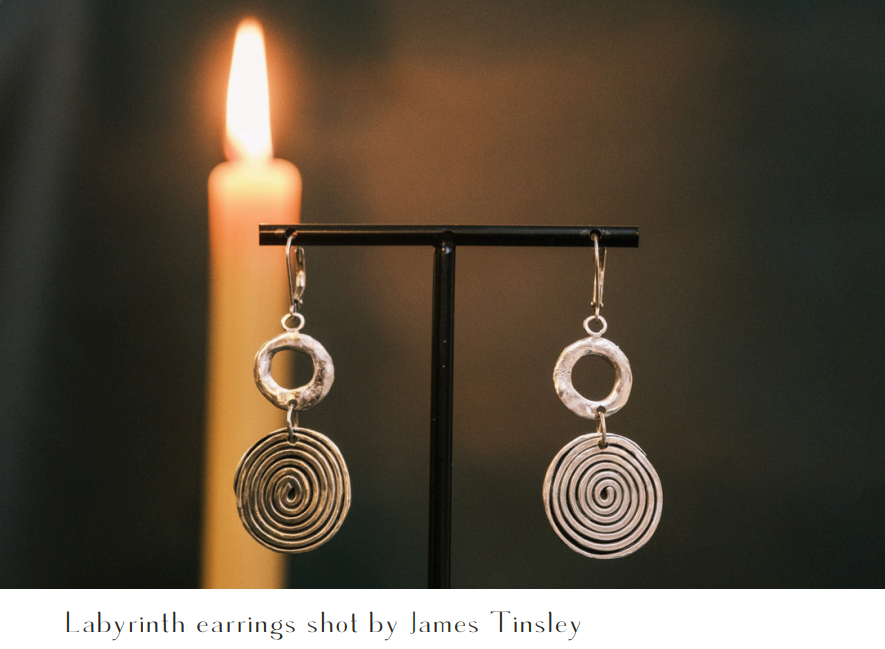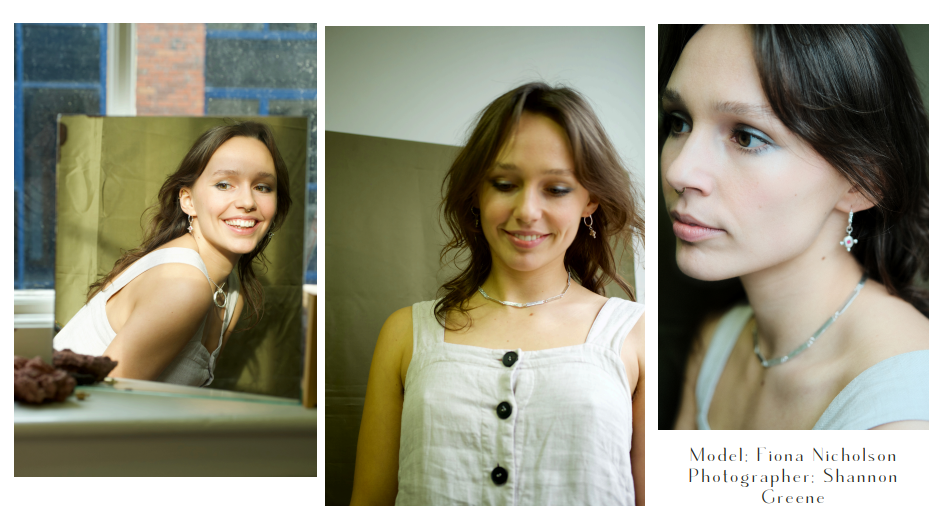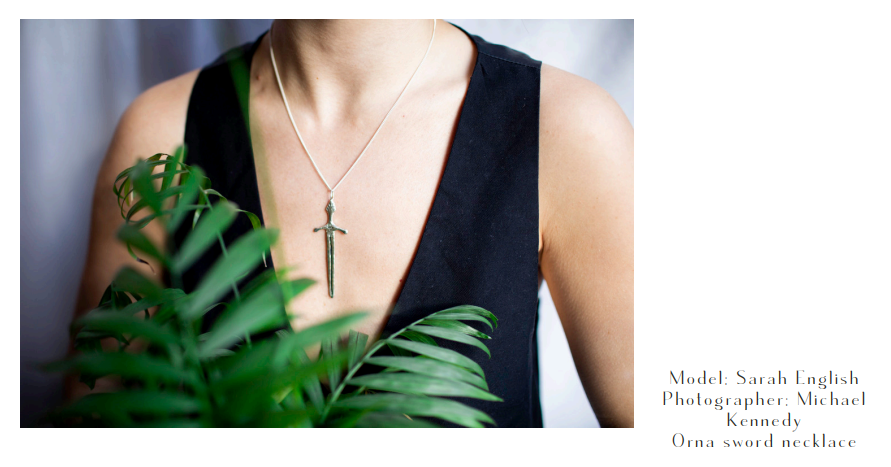Hammer and Snail Q&A
By Clara Potts
Inspired by Irish folklore, ancient symbolism, and deep personal connections, Hammer & Snail champions the values of slow fashion and sustainability. The name signifies the balance between nature and craftsmanship, highlighting a commitment to crafting meaningful pieces from recycled materials. Founded by Shannon Greene, a former climate researcher, the brand beautifully merges artistic artistry with environmental awareness to create timeless pieces.
1. Can you share the story behind the name of your business, ‘Hammer & Snail’, and how it reflects the ethos of slow fashion and sustainability, which are central components of your brand?
I wanted to create a name where nature and slowness were at the forefront. Snails are slow and considerable creatures, which is what I am trying to convey with hammer & snail. Fashion should be slow-paced and thoughtful, and I love that the name is also a play on hammer and nail, which I think adds a level of playfulness to the pieces.
2. What inspired you to start creating handcrafted jewellery and metalwork with a focus on sustainability and ethical craftsmanship?
Iʼve always been interested in sustainability. Before starting hammer & snail I was a climate change researcher, so I knew that whatever I would create, I wanted it to be low impact jewellery that didnʼt cost the Earth, but also felt fun and playful to wear.
3. Your pieces are described as “ethereal treasures” with stories “inspired by nature, ancient adornments, and traditional monuments”. Can you tell me about your design process and how you draw inspiration from these elements?
Each and every one of my pieces has a story, whether it comes from Celtic folklore, an interesting symbol I saw at a museum or a celebration of a friend. The idea might come from these things, but the piece usually ends up becoming something completely different, so I'm not too strict about sticking to specifics. For example, my most popular piece, the sacred heart ring, is loosely based around the traditional Claddagh ring that represents friendship, loyalty and love. Another one of my pieces - the Orna sword - was inspired by a story I read in Irish folklore about a sword that recounted everything it had done while in the hands of its previous owner. I have a piece in my collection called the hag stone pendant, which is a sand casting I made from when I found a hagstone on the beach in Wicklow. Hag Stones in Irish folklore are known to spot fairies so I knew I had to make a design out of it.
I love that my pieces are connected to Irish history, but also they have their own story too. One of my necklaces, ‘the Aoife necklaceʼ is named after one of my best friends and first ever customer.
4. How do you ensure that your use of recycled materials and sustainable packaging aligns with your commitment to protecting the environment?
What I love about jewellery making is that it can be so sustainable, you can always reuse worn down tools for something new, and metal is always getting melted down to create other pieces. Every part of my jewellery, including the ear scrolls, the chains and the ear posts are recycled metal; which Iʼm very proud of. I think a lot of it comes down to ensuring the environment comes before profit, as itʼs always easy to choose the cheaper option, especially times like these where itʼs quite tough for all artists and makers.
5. What challenges have you faced in balancing artistry, sustainability, and the modern demands of the fashion industry?
I love this question; because this was a dilemma I had when I began selling my pieces. I didnʼt want to start creating things just for the sake of it, I wanted it to be something people would actually cherish and wear forever. Iʼm not sure if this is a challenge, but rather something I've had to forfeit to stay committed to sustainability. For example, I donʼt offer gold plating services despite lots of people asking for my pieces in gold. This is because there are harmful chemicals in the plating process, and plated jewellery is not recyclable, with plating eventually wearing off so usually it doesnʼt stand the test of time. I have also committed to using non toxic alternatives when I'm polishing and pickling pieces.
6. Can you walk me through the journey of a piece from concept to creation, particularly how you integrate sustainable practices into each step?
My pieces are usually conceptualised from something I saw or read, and then the idea usually sits with me for a while until I decide what to do with it. There are hundreds of ideas that stay in this stage for me. Usually itʼs the concept that comes easier, and the creation thatʼs the harder part. I sometimes find my imagination far surpasses my skills and abilities, so to make an idea come to life I have to practise a lot, or bring myself back down to Earth, haha.
I'm currently completing a goldsmith course at Vanilla Ink jewellery school in Glasgow. When tools reach the end of their life they are repurposed for another use which is amazing and something I've integrated into my own workshop. It ' s not only sustainable, but also cost effective for an artist.
I also try to stay away from constantly releasing new pieces or collections, as I donʼt want to promote overconsumption.
7. How do you hope individuals feel when they wear a Hammer & Snail piece, and what message do you hope your jewellery will convey?
I really want my jewellery to never be taken off, so they are usually quite hard wearing. I often get people commenting on how they're surprised at how sturdy my jewellery is. Thereʼs actually a chain one of my customers ordered a few years ago, and I follow her on Instagram. She wears her house keys around the chain and it always makes me so happy to see my jewellery getting used in such innovative ways! Itʼs just how I like it.
8. Looking ahead, how do you see the future of Hammer & Snail, and what are your hopes for the role of sustainable and slow fashion within the broader jewellery industry?
This year has been a really interesting one, with doing a goldsmith course itʼs really made me reimagine my love of jewellery making and what I want the future of hammer & snail to look like. At the moment Iʼm stripping back my offering on the website and creating more one off experimental pieces
As for the broader jewellery industry, I've noticed such a rise in ‘tarnish freeʼ jewellery brands; which usually would involve coating stainless steel jewellery with PVD (physical vapour deposition) which is really energy intensive, and isnʼt precious metal jewellery. It has to be heated at extremely high temperatures, which would be more of a factory production scale.
Metalworking has been practised for thousands of years in Ireland, with our ancestors working by hand. I love this concept and want to keep it as close to the traditional making method as much as I can when making jewellery. Precious metals come from the Earth, and I see making jewellery as a way to give back to it, creating something out of these naturally occurring elements.
instagram@hammerandsnail





